The following blog post, unless otherwise noted, was written by a member of Gamasutras community.
The thoughts and opinions expressed are those of the writer and not Gamasutra or its parent company.
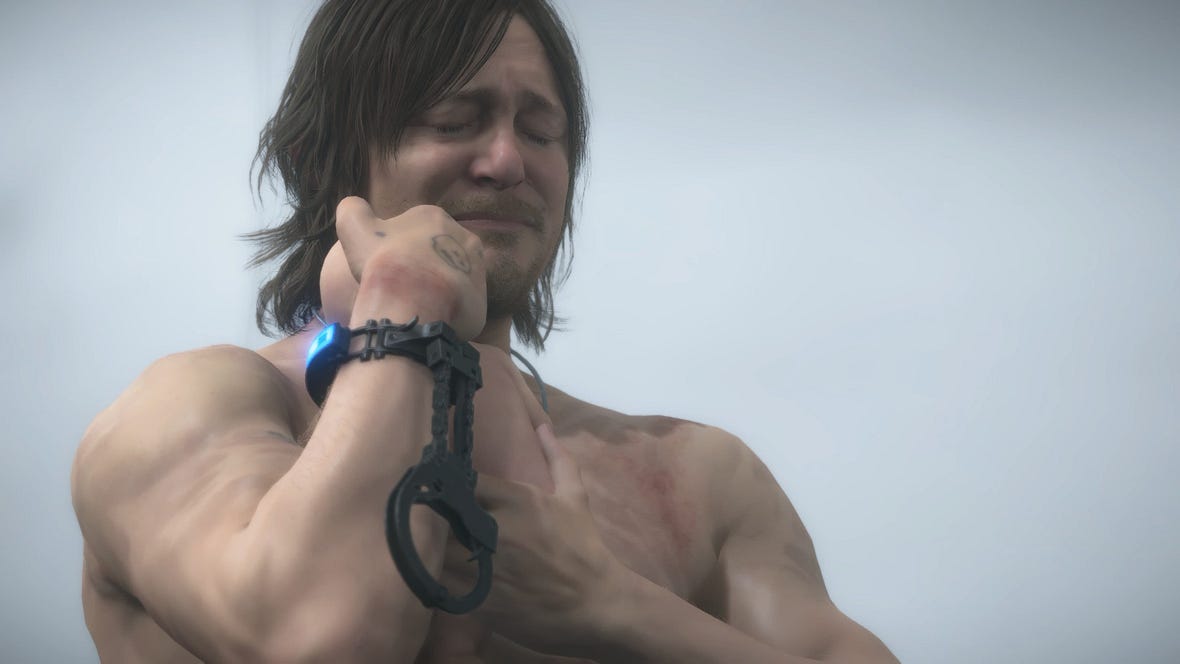
Death Stranding is a game whose mystique and development may be just as crazy as its story. This is the game that famed developer Hideo Kojima set out to make following his rough departure from Konami and the Metal Gear Solid series. Looking at the discourse surrounding it, there are people who consider this a work of art, just as there are those who hate it. There is something interesting and good about the gameplay, but the game seems to do everything it can to stop you from experiencing it.
Cutting the Cord
The core gameplay loop of Death Stranding is a “one man delivery service simulator.” Your job is to transport essential goods to various outposts across the ruined land. Standing in your way are package delivery obsessed cultists (that’s an actual thing here) invisible ghosts that can summon giant monsters if they catch you, and the topography of the land itself.
The story told through very long cutscenes is that the remaining cities of the country have become isolated, and by bringing goods and reaching them, you and your organization “Bridges” can reestablish connections to everyone which is a nice goal. Out in the world is where Death Stranding is at its most serene and where you can see the burgeoning aspects of a great game.
A Thinking Man’s Walking Simulator
When I was streaming Death Stranding, one of my friends commented “So is this the Dark Souls of walking simulators?” And that isn’t too far off from the moment-to-moment gameplay. Before you go out into the world, you need to decide what deliveries to take and what added gear to pack. Like Kojima’s previous works, the individual tools all provide different functionality and “a-ha” moments when you do something clever. There is almost a puzzle-like quality to figuring out the best and safest route to your destinations.
Even something as basic as a ladder can be used to create shortcuts through the space across rivers or climb plateaus. These objects once placed remain in the world which takes me to a very debatable system in the game. Like Dark Souls, the game is single-player, but features shared content between players. Objects, symbols, services, and items dropped in the world can be found by other players. These elements can be “liked” which acts as the game’s experience system. Major projects like bridges across the terrain require multiple players to donate materials to set them up and reminds me a lot of the social aspects of a game like A Tale in the Desert.
On one hand, it can be great to be in trouble and find that someone left a solar generator or a climbing anchor, but I feel it robs the game of that personal feeling of going out and conquering the land to make it suitable to travel. You can disable this feature from the game settings, but it becomes a lot harder to construct the larger projects when playing by yourself. The annoyance is that it doesn’t matter how many resources you have stored, only the ones you’re carrying will count when it comes to construction.
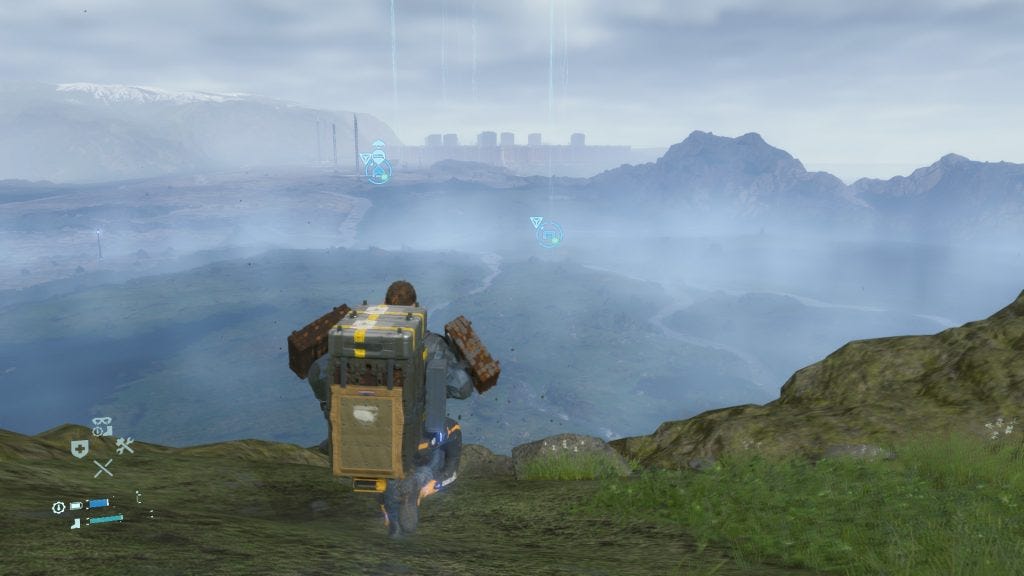
Going back to the act of transporting, Death Stranding requires a little more thinking than just breaking the back of Norman Reedus.
All goods have weight to them and how they’re set up on your frame will affect how you move. If you put too much heavy stuff on one side or stacked high, it becomes a lot harder to move around and you can fall. Falling can cause damage to packages or force you to drop them and must pick them back up. You need to plan your routes carefully to avoid rocky terrain and lakes and rivers. I like how you can organize your load for better weight distribution, but the system itself is very awkward to use and I feel was handled better by Airborne Kingdom in terms of showing weight distribution and impact. This isn’t the first complaint about the UI, but we’ll come back to that in a minute.
While out in the world, you need to maintain your stamina by drinking Monster Energy drink and making sure your shoes are properly maintained. There is something cathartic about loading up for a journey and deciding what to bring as back up. You can also find resources in the world that can be brought back to provide resources for everyone to use.
In terms of threats, the ghosts or “BTs” bring rain that degrades your packages. Trying to avoid them while protecting your goods does break up the gameplay of just moving from point A to B. One of the more unintentionally best parts is if you trigger a BT monster and must escape while the environment shifts up and down trying to stop you. The pieces of Death Stranding work, but just like the world around them, they feel broken and segmented.
A Crawling Pace
To put it mildly, Death Stranding is one of the worse paced games I’ve played from a major studio/name with horrible onboarding. For the first 90 minutes or so of playing, you’ll be watching cutscenes and barely interacting with the world. The moment-to-moment gameplay at the start is too restrictive without any sense of meaningful progression. The game gives you all these different tools, vehicles and upgrades, but they are locked to the story and not to how well you play.
There are multiple cases where you are going to be forced to backtrack through an area you’ve been through, and you must do it the exact same way that you did going. It wasn’t until about 7 hours in and reaching chapter 3 that I got my first legitimate upgrade, but even that didn’t feel like the momentous occasion it should have been. In fact, the game waits until chapter 3 before unlocking a basic fast travel system. The gameplay feels divorced from the story, and we’ll talk about that next. The closest analog in terms of exploration to Death Stranding would be Breath of the Wild, but BOTW was focused on making the exploration exciting and interesting, here it’s just repetitive.
There were cases where areas seemed like I could climb but I couldn’t. Despite how focused the gameplay is on transportation and travel, you have very few options until far later in the game. This reminds me of the poor Metroidvania design example of purposely making the game feel bad to play, to only then fix it with upgrades later.
The UI was a major problem for me which also added to my issues from a moment-to-moment standpoint. Nothing appears to have been doing from a UX perspective to make it easy for players to find information and enjoy the game. This is one of those games where every button on the gamepad is going to be used and it felt clumsy to play. For the life of me, I couldn’t find a way to manually place items in specific positions on my backpack; only the auto-sort. For goods that must be kept flat, this becomes unintentionally frustrating.
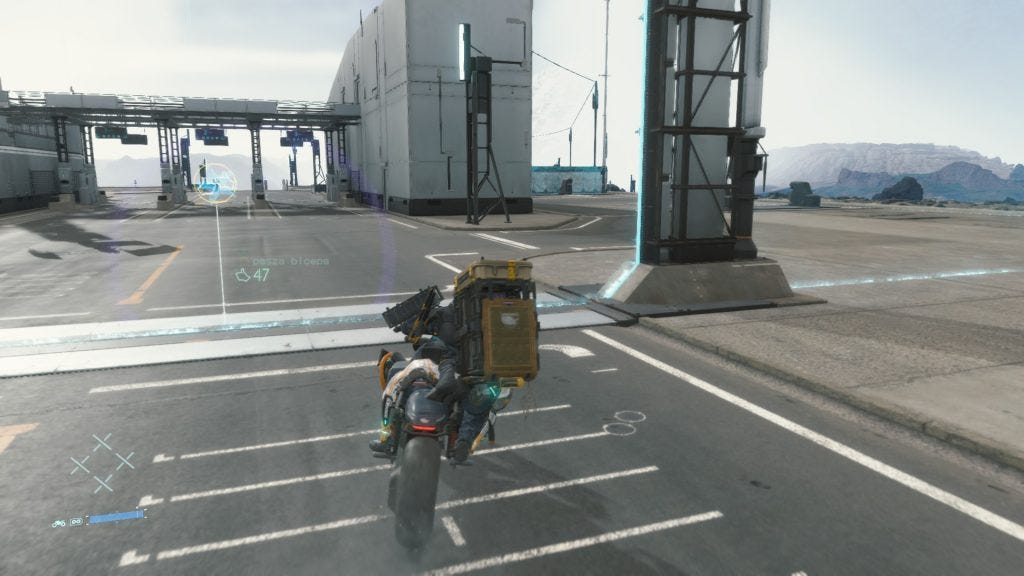
There were multiple times where a prompt that I already saw would come on the screen blocking my view and would not go away for several minutes.
Selecting tools was more of a chore than it should be and just everything surrounding the UI annoyed me to some extent. Here’s a quick one: the game assigns the “accept help from an NPC command” to the “punch someone in the face” button, and you can probably tell what happens next.
This would be the part where we could say that the story’s job is to move the player through the rough parts and keep them invested, but that did not work for me.
A Soulless Story
There is a term critics use to describe Hideo Kojima’s style: “Kojimisms” for when something weird, or potentially controversial is in his games, and Death Stranding is peak Kojimisms. The way characters speak feels like something out of a bad YA novel, with cutscenes sometimes meander around someone saying the same thing three different ways. The game leans heavily into the chosen one trope, and Norman Reedus’s character embodies the “moody teen” archetype we’ve seen countless times before.
The more I played Death Stranding the more it felt like despite coming up with an engaging gameplay loop, the development team cared more about the story than making sure that it all fits together. In one of the earlier sections, a waypoint that was literally a 5-minute walk away from the major city of the game tells me excitedly “you’re the first person I’ve seen in years” when a few cutscenes ago I was told that there were people out there doing work and services.
For a game people were decrying as art, there was something off-putting to me about seeing giant cans of monster energy drink in every private room and using the bathroom would display an advertisement for a show that Norman Reedus was on that I don’t think is even on the air anymore. Playing it on Steam, the game began to constantly bug me about the Half-Life collab event so I could get a head crab hat. Just wandering around was often interrupted by one of the game’s moody songs, along with the name and artist in case I was so inclined to buy the CD.
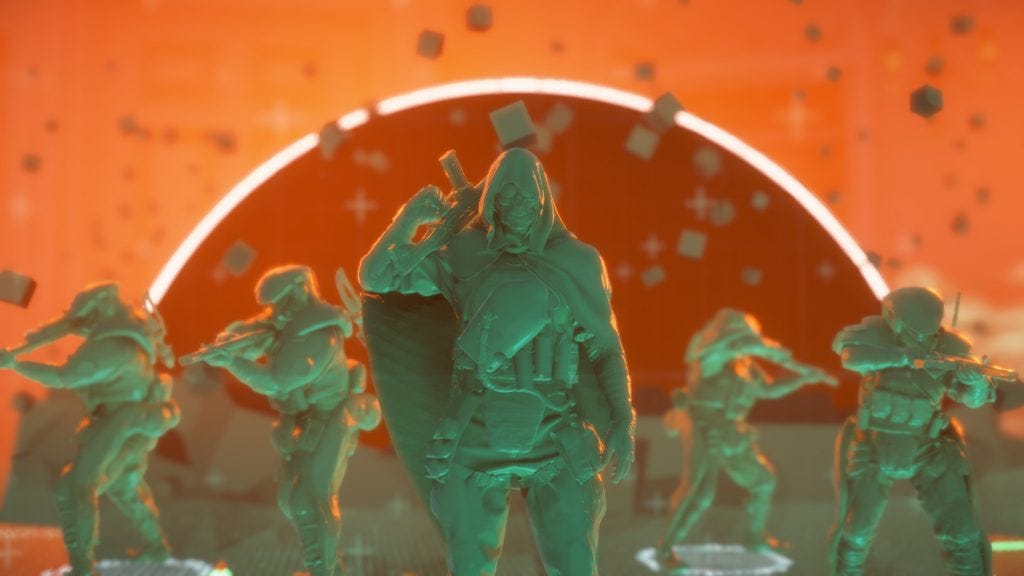
The moment where the game lost me was when I realized that the story and the gameplay were just not syncing up.
Delivering goods to people doesn’t change the gameplay or impact the world, it just gives you “likes.” Going after the cultists doesn’t change anything: their bases are never going to go away. Instead of the gameplay influencing the story or vice-versa, the story is all that matters, and the gameplay is simply used as the vehicle to go from one cutscene to the next. If you ignore the story, there is no way to make progress with the gameplay and unlocking more options. I am sure that the game gets far better the more you play, and actual gameplay unlocks, but the pain points and gamer tax are way too much for someone like me to put up with it when I have other things to do. It wasn’t until around 9 to 10 hours in that I would say enough gameplay content unlocks to make things interesting, but that is way too long for a gameplay loop like this.
What frustrates me about Death Stranding is that when the game gets out of its own way, the gameplay here works and could be the focus of a title, and there is the perfect franchise to go with this core gameplay loop.
Spinning Our Wheels
Exploring an environment in the most realistic way possible and transporting goods is a niche, but still fulfilling gameplay loop, and it was done in a better way with the Spintires/off-road transportation simulator franchise. The first game released in 2014 became the basis for a full-fledged sequel/spin-off Mudrunner which has been followed up with Snowrunner. The concept is as simple as it goes: drive across wilderness maps transporting goods. While it doesn’t have ghosts and cultists to get in your way, it does have something far more insidious: mud and snow.
Right off the bat, the game’s onboarding and tutorials are years ahead of Death Stranding despite dealing with the far greater complexity of manipulating a truck. Both games derive their core gameplay loop from improving your ability to transport, but Mudrunner works that in earlier and with more meaning. Getting access to a garage or a new truck suddenly opens your options on that map. You are free to decide how to upgrade your vehicles and there is that sense of accomplishment of finally getting the goods to where they need to be.
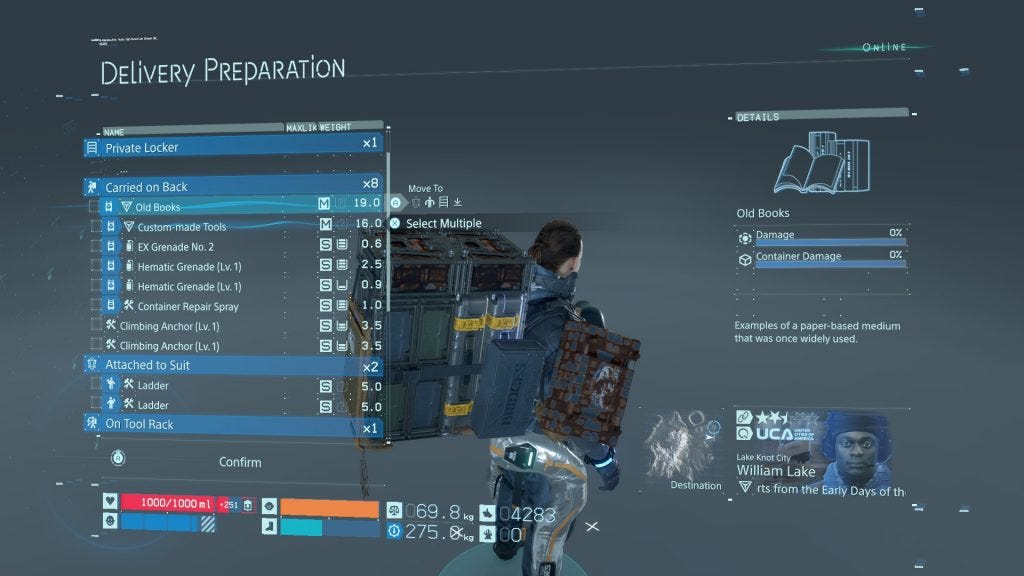
And this is where I feel there is potential: give me a game with the adherence to preparation and transportation while exploring a world on foot. The important element is that the player should feel like they’re improving and being rewarded for doing so, not just moving the story forward and being pulled along for the ride. The fact that I’m supposedly the sole transporter for one of the few remaining corporations in this world, and they can’t even provide you with one upgrade to help you out in the early game is baffling. The game is set up that there is a connection system with the various waypoints that could have been better used for unlocking content and changing the environment.
The problem with Death Stranding is that there is no meaningful connection from the gameplay to the story. The real meat is with working passively with other players and seeing everyone’s contribution change the map and help everyone. What you do in the world is never really acknowledged or cared about by the story. Long-distance traveling (which many missions are about) doesn’t feel as engaging as going from one end of the map to the other in Mudrunner. Mudrunner constantly keeps you on your toes about what you’re doing and how your vehicle is handling, Death Stranding is more about turning off your brain and just zoning out. There’s nothing extra for you to do, no reason to explore, it’s just the time-wasting tradition of open-world games where only the interactions at points of interest matter.
To put it another way, this is the difference in feel and movement between Marvel’s Spiderman and Sunset Overdrive; both were done by Insomniac, and Sunset was vastly superior in my opinion. The reason is that the movement was integrated into the experience to constantly keep the player engaged, while Spiderman was more about that zoning out feeling and swinging from A to B. The more I think about it, your preference between Spiderman and Sunset is a good litmus test regarding if you’ll enjoy Death Stranding: Do you prefer to be always thinking about how you’re moving around, or do you prefer to relax and zone out? Let me know in the comments.
Even when you finally unlock the ability to construct vehicles, you’ll soon realize that the game decides to take your next delivery missions across mountains making it impossible to use unless there are already roads and bridges set up. So much of Death Stranding seems to be about shallow depth of its mechanics: the pieces are there, but they’re not being utilized right. Either more depth at the moment-to-moment layer, or a greater focus on collaboration and teamwork could have made things more engaging.
Stranded
Death Stranding is simply not a well-designed game and fails multiple game design lessons in terms of onboarding, UI/UX, and pacing. There is something legitimately compelling about the aesthetics and design they went for, but they are crushed underneath poor writing, guest stars, and corporate sponsorships.
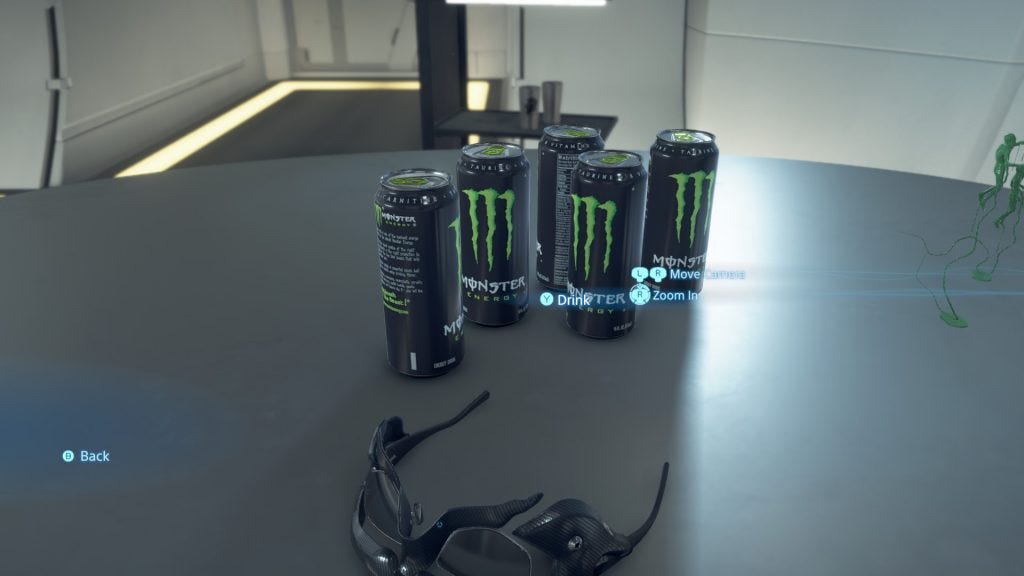
For people who can make it all the way through to the very end, you’re going to find one of the most unique game experiences out there, but that is as tall an order as asking one man to run from coast to coast.
If you enjoyed my post, consider joining the Game-Wisdom discord channel open to everyone.


:strip_icc()/BHG_PTSN19720-33d9cd22f6ab49e6a21982e451321898.jpg)

More Stories
The Ultimate Suit Lining Style Refresh
Review of Jackson’s Curated Sets: Moku Hanga Printmaking
Gurney Journey: Midwinter Greetings